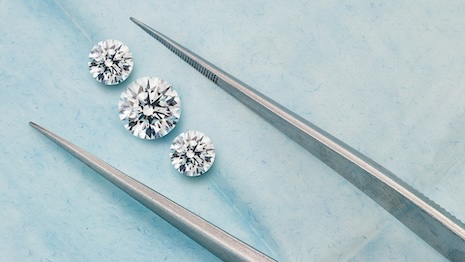By Jamie Saucedo
Gen Z continues to be a driving force behind many important conversations, a demographic commonly known for its derision of fast fashion and passion for sustainably sourced products.
When it comes to jewelry, Gen Z is instigating new trends, forcing high-end and luxury jewelry retailers to sit up and take notice.
Similar ring
Last year, jewelry was named as the fashion purchase of choice for Gen Z, with 58 percent of Gen Z buying a fashion item at least three times in 2023, compared to only 41 percent of baby boomers.
Trends that have gained traction recently in the jewelry vertical include lab-grown diamonds, which are becoming increasingly popular in the United States, with Gen Z leading the charge on purchasing power.
It was reported that the sale of lab-grown diamonds in the U.S. jumped 16 percent in 2023, given the fact they cost a fraction of the stones formed naturally underground.
Lab-grown diamonds are also increasingly being turned to as the jewel of choice due to the fact that they are chemically, physically and optically identical to natural and, inevitably, more sustainable than the mined alternative housed by high-end jewelry retailers.
The question is, how do luxury brands use other ways to compete with the new wave of favored high street lab-grown diamonds to come out on top for jewelry fulfillment?
Small product storage and inventory control
There are many tactics luxury jewelry brands can employ to get ahead of the competition and deliver high quality goods, fast.
Small product storage and inventory control can be harnessed to deliver the best results for customers. How this strategy is managed is integral to ensuring small charms, pendants and other jewelry products are stored securely, and accurately tracked for loss prevention.
Upon arrival at a fulfillment center, items should be immediately routed to a designated location to be put away to stock, whether that is a caged area or other secure location. This is especially important for precious metals and gemstones of iconic fine jewelry brands, and having secure facilities with restricted access areas is key.
Inventory control relies on standard operating procedures (SOPs) being setup to support the unique requirements of jewelry inventory.
Inventory counting and quality assurance (QA) must also be vertical-specific and velocity-based, meaning the item moving the most is counted the most.
 Jamie Saucedo
Jamie Saucedo
Personalization as a key differentiator
Value-added services such as personalization are a popular option for jewelry brands and can offer an effective way of enhancing the customer experience. This could include engraving, embossing or even the use of embroidery within the product packaging to offer a tailored look and feel.
Product packaging should not come as an afterthought. Done right, customization of this kind can optimize the unboxing experience, and act as a distinguishing factor that encourages brand loyalty.
Scalability to any volume
Given the increase in jewelry sales around holidays such as Valentine’s Day and Mother’s Day, and over the summer months when engagements and weddings typically happen, retailers need to ensure they have enough stock at these peak times, as well as the right technology to scale to any volume as required.
Technology-driven picking, system controls and built-in quality assurance minimizes training for quick scalability, high productivity and accuracy no matter the volume, meaning the consumer will be able to get the product they want, when they want it.
Multi-node and jewelry fulfillment
Social media platforms are increasingly becoming a means for driving retail sales. Therefore, it is important that brands look at how they can distribute inventory across multiple fulfillment points and channels to ensure the faster and more cost-effective delivery of a chosen item.
A multi-node operation has the magic formula for enabling this, as it enhances scalability and speed and broadens capabilities when it comes to demand planning. This also includes a sophisticated transport solution which is especially significant for jewelry and accessories brands.
A multi-node network powered by advanced distributed order management (DOM) technology ensures brands can offer competitive delivery times across regions.
For jewelry brands, undertaking multiple footprints is possible without taking on a significant amount of overhead cost, thanks to the smaller footprint requirements.
In locating product closer to customers across geographies, brands are also able to expand carrier selection by incorporating regional carriers across local markets.
Omnichannel fulfillment should be another key consideration.
Often for higher priced jewelry items, customers prefer to view the item in person, before making a purchase. The customer may then want to order the product from the store to be delivered to their home when available, or alternatively, they may want to order the product online and collect in store.
Regardless, convenience and ensuring a seamless experience across online and offline channels is crucial to meeting customer expectations.
To achieve success, it is key that the customer remains front and center of operations.
For brands with a bricks-and-mortar presence, allowing customers to choose the delivery option to best suit their needs is an effective way of promoting customer satisfaction.
Ultimately, a tailored approach is the best way of ensuring long-term growth in sales and a customer who returns to a brand time and time again.
HIGH-END JEWELRY BRANDS have the power to contend with high-street brands and protect their stake in their customer-base, as long as their operations work together to protect the integrity of the brand, delivery options and customer experience.
From creating high-end, customizable packaging complete with a variety of sustainable options to appeal to the environment-savvy customer of today, to effectively managing inventory and using high value security to protect jewelry lines, luxury brands can take the edge and guarantee staying power.
Jamie Saucedo is senior vice president of business operations at PFS, now part of GXO, Irving, Texas.
{"ct":"n+UBS04S2MO0VdzdhPLQ0SCJWcM3OnWj3lM+xRUtnFKehsU\/8sYEdc6oFfYkUAvR41v27D18+F8ZN\/yQk36amCL\/e9BSRIZK4hnvtFKyoud5wNjHtBai37jeEepgDdfL0a6hAsOVmzh5AIhAnNJeqBfSwO0tYGPieTS8KdB0oEH6Z3wF62zQosuC3Y0XAHmD7b4fM4nUEchiDiyhT67ciHbzcmzRhJ3ovxFkue4no7O+1WWG8cihMsN0tYosA9tMd6BEHTQrVOG8ZpXKZIqJELm2L46al4\/nSQM8ElMqV6owdb+PepxpLaG7Kd0zbEUsiCAEhR0LRRcGVIhVElAQxgSDlmhUUCXEtkywOnUdtzTKtP5aSE2zRz9KMfT8HnTl2tK4ZKETM6bVWihjacSRkmxYxcCcOLIfAxAR5yiG1LDIzXD0wqpl0CNPk0FxnEqx1oVNLsR+J1dt4ZBUVVN5eXkw+iDe5BPdi9KTv4WXaHPGRmq7gyisO8Hznt3vB5xV1MO13WJk8xVyu92Jr84bZKxbV\/KzzPoZqiKcp3Ht3rrO+mUxgnN9sJni99StY5R7yKgwuh3TRITR9q+Ozkf1d2TkPq3XnOJ1GL4jajTbEHgFwL5j1o2x3F0y6GnGZpaYvDcgx7nP2h21bsIMnx9dsUKN6OrUFE2bOq84Tm4Y7ds99znDQgkE7hziK99t1oIYqJNeVikRWoiF4z+gMLIGNuwDzHUoAuLOtrPCcjiMekufIcMaKrbE5hceOBCyn9h1VPA0b9ADBwa7pmAjH33SiQRB8bTqMTgmRElO8CH3c74dg6OzxxgiKb6TibzfdES1Rbdk\/YjvMN3e4Ifh7MXiGBnV2xuPULqw6dH6qX5waDbFzCU1O\/LGuzRI\/sQs4IoK8Ts\/C\/YmFrRKZML3oOYP\/4wljfiYHu2eQYtEs5nlz6yQ2BR5s1MewB5DhLU5uKJCRqLHybF2CoLv6IASMANOcGnaC70pdI9VWgUx++wCQ3Gu0zqYPFNFlgP6VwvsDNusN8yJDZMtHeaNGLRfYiurR0Vr37zOG\/FPrU+bMOrsEfjhy7qyEwzTGFpSNDKEZY4wHM03rVgDrmZur6Gsl0d8gjEi5OpLSoHxShRVVrsRhN67y2vAP3GfgpwPM5o4RE8zgJH8Mkdto92Sfb3OmNGH\/8HkJhirQbua5\/+\/Y8pgqc54dmPN7azaC+VB2KVekmsAd8H2ad9LWmZduLHdLtJ11ocVK3HmGaYMUvxvAtbFAJH7vk1tqEfTDcIYUC9k4Y5pH8FVVoNaPZuyJjX+CRyJIkfgzYIkA+dZhx4V1JBDLdeFQbjoky3wp4n3BOyMExkVGUI+Hxhix8oznweMAxWJKzeGObac01926exxQIPjTj4\/1xeiRpa+3pU1FXLDTKl6RzYrZMhrs3T9k+RMzOC3ORO3Xnc+MiYq9XFsomH8zihcQ0guMJ3K5J5QgfQHqNrIEL4DkUxj+hBWfkThQY+4CnOxXtejuDIRT59xqxn2qoVd6obfd5wm8jMrkJOQmwTG7\/tqcYtymxvrNbYXF48toRXXDBvS22qet\/a5JUyHV+liLwekgVa60OiueuNNcLTyIzMOtfuCbB4Mt8aVtFmV+JW2O8D9rohbMCUVYRPNoCAjLO726wGfWX3zvrXtAvJ9lGdkCd65zIyHW9pbNUQJc4nRMpHu2kSc+lTbomgm54c0l2wU+nq2MtbQBsFZcsIcGNeJP9NIPvUk1r6ojqqB9P2V+HfUjLhLDFP\/huxUG\/oyqcywK9xpGBZ0o3N8Z6WWdpWU\/H6BH7F5M3e1hMlqF8E4ymjDQWxqBSISpDKItTwTEfgSXC3GFWxAY5JMefLbaZAGRtOtzyzwYAfdatLKmy3N9hPPeopwPdUehu8pKox0yw9BSwk7esuLeSAzDay3Y2IaDOnIzEQfmtbY0V08OddYHLYxBSSxQe\/uyBWpgxx8b9RYI\/cCymzzJLHWzeNaLYWVipa\/k6wJg\/FI\/7vKGDlbMfZ33hLqXAqjfyYTOjYMNo8mmRTs3+7yiXoDiNcjssn1xfY1A09VsDi\/Xfch9bypm5x50jgYVXpgLwWxVrTSeO75rDs0BbD04HxB41zzIEqYxbhc2XYEsjspW1tnFZQYXwvGA3akdBg\/yTXObgU4qXqABTN1kuEiP0Ezt5SsjokZrfwVM6jEwxmg1kr1qtntCLbW1yMqz95uUlrAk7Nvwl6rwUK4L5ZzNs1HWnRLaPBfQsBCrByddJw6A7HrfLwCWOjVByc1MpPLWDaCbf5\/EsbDn1\/2Hw1rRSUvhHDj+SGcoylIxkbcztqhGsq5IkHrceW3DWJuD5CLDJ2fjLP24mIH0s2rUgS8S3RYhTpU9iJ+SVKRiTSIv1Zanb62HrgsvtqISUlEPG9D6RcaIl6xsxCTcztWfirc1A\/vimVVoiMo33uZ2E3BFP+0UPI6ewZlks4k120NUNJt2nLEnOHiRYHsiXP+RoNB642p3N90pyjjujbspY0WFQ2CKky01QDYrhKVyAphzJVS0esrDK1d7Kwd+R7TZLgfNLppNEVHcCACv9z7aMFCossOhPvT7OmDE6wtajgA0bU14U5yCkMlDVb8EQZg+ZgWc3Gbu\/dVOIljwobax0sVCWL7soEw7Ml+6DmLvVxcViy3l8gMyfzokpWNXqVFTSVf07TcyCkbYpZIk\/KGRTecXjeY4Xlo7Mz0r\/frGhwMDFH2\/IiS595sT6++ELDCXID5r\/vCT2RE2XwTrizZbY31LcwrYnh3CH1P7Ix5dtWcJBDM4furnW19BND6YYV5FklOWnZKtFOxbkjhhZ2q3iB6PVqC3G2cb94OHaWPUnxbnpfurHvGZhm9oMqYJTtp7Z0o0TLW0cZz8J6u+iMPyye2NTq+ubxjsT3s3UybUZi7RZO50yvt+twFy7rIKtCgvUDzfB12uMazI5DJPd+XuA7mLDlKDFnJkxCOZPCpiADykLv47z0mJr63RWF4GzmRMpxPC0I2FvDMlfIa9mSGDQR4yIgn8h9dFpzS3zm2+mhOcDgo6gAsr\/V9AcPB7k+3+v0xq1YsWnxnpjmzSZhDJqnPCN0r58MCBOjWU8PrXr4hZayHOEuXF7MleRfi+Zoon9SCNvzCW0yTaFzQjdr08rxnQZgmL4\/jnGwMTIrYv0UAzqY82Y4O0bNXuvJd2\/5OAD7dhZLDx\/z0XRDnVZZH80IacvoJ1lAKlkIuvChy0\/GUDP5NNaKuoKf0dZKMmEdbVJ7bVkx9Sw8C4qV6QjaOQhEGxjRT624Z5z+64AAX0aHpCRHzIwsRgxNJ14tNy2FC1DpxmrxcSfBZvCfi5TCnMzQPvQFGoXucALiNlZr4udrf1WGL9VroDM9zp5lo8aAMHrcmgxY7YbuTZ8TDX55DD48QH7SoP8tQpSOBhNZ+x+BwmCR\/eB7G1d\/moHEckZkP\/REEIN5gBkFAXnTLqttbM6vTV\/agGjglTmyuZVPUGhENZvQSvCFIwDG27NPX0OxUi1gwdt2hykcUn41EOxc4yeLvcA1knbLmrzzi4Gvv+5op6tQEGnv\/jqv\/zjgnLZSgvqDtD1xLkv6Pp8RWsnffIMv4hroBtE00YJC2M6zy5KGMsWJSs7uDM0xahOz1D3UwaYAbsOkXWKMeNcbPvspJi79dj3XNp\/5ZVG0Gy3OCDPxPhhMOE94pw9tvB2WzUIM7JbLwXLES9IB882BmXz9a7Cv4e\/rRDdI1cSvVnL4H89aK33Dau+G8eFZ4fRytf8RV3\/XxIaukYa2pA59vLOfT+3MGgTaZuUX6GFgqJrH23RSYjL6kyD+o7\/717MxoB3d5MXZRB2McmlZ1+cW2ONKSNeOkBllOVAvFe19VNmIA7FIqBm+JmNgFh40QbTfg5oU4tVxGlj4xcOtrwV6U2B8D6LuTqHGE\/lWk7\/imkIU5ymnvv5pUttRKPPgCSC\/bdHZCiekCo+L5pHPckIoxRZd1yi3UcYLj3U4fnyyyF7vCnnZwQ5dEEKgMh+lTi0805ngK55LWhryLDG6duzcb2hSDmJql+At8YW\/uM8S0L83QQtClOzFFR+fm87zeGLxHUVXr4bgB3DbwMaf5THJlfjS1eT7EdaajRLp2Ik4o8qD1Mq14NIm3K6kIdAGiXtHOesYR\/3Kx7+AUqeJDLy0xmXn9h+qsKt8FeLMMOtu8Z9HaajTT53YEd511A5zPzUlD7f1dQyyd3yjxIIx9pqiP6zHGzK19TVADk1vwAUBYE1GeGo7DgITR3oWzSxTdewl4abpQDcsuAI\/R8D0M4uVNmep6dEafAzsWWJnjfaDXgtljYY9tQuFa2JA79YI8XHnyrifCOHFLeR\/oMDnRMNYJRuRg3b4cVSG9X6vZEfapV688AjjU3L3SuYlSRc8gKvj9brzLSgggTORLj\/IkZi7EYoifyUBR+yIvcNEgHieW4IFbG1Yqr0cdvr42YJpuk2KiRaJuC30fXuxm7EhhVVk\/ba68DIgk8kIr73HP4VtrJStcNoS94uCBQrluxSe\/3Tc+L5Jc1b76dIIjwLNIoFUjv906Cbptoo71Ue+ji4PFwJ5OOms4BadvTxyPkQ8CGegiEAVBpeBAbfxrq5rRgS6NY+zOJOnOwsCcnpmPWbezgEDEJ1I9UOxjiGtWxZeEPaYvK5\/9FAmoPKwa4\/wBhcJUKkhoX2mmR9h20k3Ov6teguAPgISRKucZ1oXxZgp0gs16mY6j7x+xBMi3KJcJdODNUL6z68q446CAmu3mZGLH5tiueJq\/NyUm7G2C9aVW6Ld61Dl35rq7qOO5v\/+H7Ib9vJsxvhC6DtNZaCZ6fgCxDqduBEARedjVx2WwdstOC8tldDfTWUj2Cc8S643KUPdmV4XFsBe0lQo9CBWLe6jtHylY8E14sATH5pvc2GjycsCYo3\/xdS84XwAxFJnzjqrrpTjgsA7iIEXYrajUmIdRPPHYlv4q8fVbzSRTogZYZUTAN5e0C9taN\/mg1tkKTbcJw+XRYJ\/4ZEK3LLMz4lGqOS2P2eU9cyi01JoC7IYs7q5mwLtPUr4KD07FCaH8SXbcuWMw1Ghrl0qlDHvTVYOmGYcD+RvolW5nx4yGI+oQFchvLn9iDRHsdlVaVSeqUL1p0\/+KaQ2jcvGayMvaE4J7N\/DyZlJQJeyL2lVTWkcsqJum+H5cvMCrLPSsefknwdmEjlS33+1X2CnowLPQW6mlyWK0LDiw7htT\/OgBAN4NT6A04IyJ1FoalmYz1V\/hgrAEsPiHRQhA4icPkY8FDrdIyR5V2caw5xZPxH1bx4kf3HeoQDDMoDtaydTqJfv\/uHLcG0AiRCdYcHX4ZkOBTJEYYzSAESAtItQ80PM6kz0ykSOmsvRMcD\/2ll2BR6buzDDMT9zWC9LbCfqk\/f+8hL\/TXpFjnlUIcXrvftXsf5Yfxj0aQTjmkImmBqPF2pxf6idMEDKa5NwjUitJHOTx9zeFE27D+PBsPAv\/XHQwg5dXuUpJdUeVs3kNFRsr+53CTzhdRM3BCoeNjE7vpUbL3fXbrFxsvLS0kXiUD2d9+55+q129xOzSftZQ9xT+cNQ7HOgpFmIzMGa4QvJXvoZJGJwFMhWPfg97zXnX8ErkLJRJWd68iyv62AAu+6JbLfOIgwZib907l+ububJImcbT6m2PjcUePlnDlNM33rDMyWrp5GCGLzqgvENj8BavEpLMuYrHYGhgG1\/fz4kM\/wxQ98AOOxwr19Smo3d\/W9rcCsKq6nJRqBTywctAu8JbKz3QzMuVvvy8i88TtLXSypsLmvipcU1\/IAywmKjLa449RxJDTCSPYCjJwqThZFfxCAZWADEFAkVlPzZnndjmniWT0DZfiiatNMpuVas+wl6irB1W972ApL3+m2zn\/4ryZWjV8uy3e9CGpk636UPe1gsl002xUp1mrwUSm1DjxEWgH1Wr\/4wKwX1XHPCHZ1m7K1bDheuF\/M22urpEBcIh66v+Rmab1tq6NVdjMsRT6j6wsDPnYLh7+1TcQlhIYOIIcerWzJJx8hYMpxoMAQWerWFde\/B20OPoBm11A57Zz1mvRN\/6RbnPB2uDvr3EC05\/CgO6sn\/kx\/TpBKk2i6jdbjtWN3LMBgsYcLM3PvCePGng6YuYkgAqt9YpHzbCuf2yvhFwki3UoroqVhBeAcDZDO8cdwryaH0A9v86v9MuRYRJZeVh8N9LllauaFitz+rxJcDMPwKbsmCCZ5n8nrjx4xER2+VmSrLKNA9BtR6H6YoPuTTKdUPEZ4K5UoYmkjd1RvPkp+yykp67RJE4VZHyiUPF34KD\/t9VnrHLVApuz+ArJk3oMUQvZ3JxnIifdWtgcxGCRksw7UYTwTJtpCL\/hjC\/x7OFtp6GOxTt250ez9FRgzvGbXS+ljTZKdCqv\/0IU5Rn7q87cz9qYQu8gYaE3PN5XMEDXOTz+dJ+WLeoNq4FUF50TtGU5XMEyadVHU6RtBQJbh1mRB8GzRmu7AjcC7YuMC7mLpYDYrjnzP\/qBrJEnkvYDAkBr+qnEUPVxzByRSHvkwGcqkj3S9S63MrixH9uhlWJ2zZKZkdm+bQHo7ESpbrx6Mp3xCilhxl4uX9kfOpzDfh91U68TFcSNuHpik+JhxwJ2tfOIb005Y7CTMMoWlo4cAb8SrEYXkvgffcKfH39oSTVPeREpCcqmqeTXDvAJV4G7UbNRV29A\/XSFyHoz1dKz1exu+DTz3OprsvWRVveYSUyAZ\/nkrHHVx81oP0SJWJJ52mKnIY9A7RcEZ3C5ka9DBoDf3B30a9XxlimAofP7X+TJIUPTDIdj9rUABreQ6PCHkx5DbZiT6gpSobPZML2mpGtsIo6WTpEnU2sXne5UY2izp38IRI61SNjME6QHbmlSwgZq1N+eEjugKK9vhm+VOlzNkKsCPocyzdfitI45juaK744NZkv2la49PxNxjK7p+nDA4pLfiVcJ4UKB2KlCZ3Rld6ZFWurRvFzdxyj8\/NmQZrzR+PnVQ8VQ+0gml1hZkEcHo2QQTvyZCAKrUAZCT1DPEOb5O9XflYPCy4RnJ9r+mcKhBIZP8Vk3CtjiKxuC3DmXcIpWctyK1eB0RdZmpPH5\/v2WTJok13CEXaBx1zeFtA+qt3l0R2N1KaDvc+v+jTRAKqodNc3Gr0RruJgDEAXwmgxKiKT5TTxCEeePv6uxL6\/kw1JH2LOcqTqG44KQ59kFI7FAh5xLb6Xuz+8HKQkY9fH0uBQO\/7t6R5hY4AHhNr\/M\/pQ78tovrWvYKe+6uUl6WFMEz9DOTq+UW5Tw76iqdsjMwfGRlbjqO0dHAxzvaeKnvOs3+zx2Q9in6Y3IFZXB4VYtzppvN7uxZkhK\/P7W0Z+BZCpC\/UjmVUeqp46RINFVHdoKkkdV5riE1vLj0osDkMJEW17Iv1z+7MvI7AOgvqZDsg2dfmtD79VeK2NaGl4sqws7\/5VJPClzPq1kgqDawTw+snRkGAwDZIXBzrvppsVlcdWZuiC5rgR+pBSaEUyV5GAwrjeAaBvxlG+\/qndfAG5NPd0gOUec\/AHGu48KiUJFlJNGlTGqB+i8sq7xCmB3RYgKkkQuwFPWlR\/QfRwxZLLuJt90AK\/FTsY3eVwh2XxLTbjIWqDZxKPAeOVAkoePgjS2xPg29eveb03mfNGkNdNJxpeyC6v0fAip5JuvlePJB9a6+9iqnMEcazcCZSwwvH37fxritGbEvNGb7UueUl+\/PKAIChOMWsKIgvHRMpsuEFjeIQ9\/j0SiZvLqYmEe\/4+kqsJ6lOTtNoDl1n\/CTbjB6QwbdNCoFBVdHdxVdXBWWj6eNAeHU5vmsuv1Zk3uLkSXZb9\/pRuztwgMVhAdRPkM2WPcC7ktjHs+8bshwCqOwpFyLlGN8S7\/uA6mkgK\/X\/5ADKZHhSz14jCpXnMJMVJOk6cV9UQDskBrBis+OiU2GcxDaCTgnQgq0YK9SzRov4gm9NG+tqYm36tRG\/D0aUVdV+YCkSaUIDjPRTbhVf4w8CFjMoGfu7lieCf52f3sqWM05V7if\/B8kWbNrZTAZPbC5l2g6vPTADVQaF5ArZZ3pc4lPD9kOvSoHrBy85ZzhBwSYaq9jWEagMzUl5VmyH7yZPl\/PQmOH5kFPIbmtWtmGiBfFEqrb66nE0UBZteGb0V5PyQMHfEvizQkRTs25eMExNIVjPpcTg3sy3Pd+59cF3AHtdSYih542fNPSa0q+zuIXDovtbGcuy\/8kvIwNS2OtzIa2ge+h1iolAtjsUd8GkiEnqPEczugMrnw0LiBoOAmqP1U+yYmkv7xQb0BcrxnR9HQbpxY4mNphAcBj+hIXFVKWviorR6LsgIltUfv3\/5dkq65Zcq9Ne6kcyNCtjdpfV8FRxjM6jY3GDYDAb055gzjLVQh1hwytE2cvp6\/xDLCr9DnS2rrI67aESd\/2pTja4XbYFdKTXoi12jgsRgNUoUjzlYIrcTD370kjxe\/IE8gazA\/SVAiZCSC7PLQOwS3Tsi2LWxbk8CPAIYf2mTxs7xvs34DDNE2wtsmj324tSyYdqUxxZYl5CZQvAQw6ZVVpAWSggd2Ht7ncm5K9J+gNERZ7MaeehR8N2CxO5K+9hbsLBmgmtcErjhB+O\/ymyafIzltSSSyp0zTuvHk1xGtoe83sHHzh8IiZ8PZmj+Khyl0NkyaPjCXDHiglgEVW6TRoBf\/\/jeWCd3Xc6uLPS9G36mQuoe9sGp+JQ+qhNleZVMgU2RyHAxICrpQrB8rZOg2iqKmnTEgl0bYNS1futGDLWX9axTyRqrUWd5K5nFJE9LtJtaoS3iSM4AQN7lkvO1KdVvXhXY1z\/l1JzOTDoAb14kN4lOrW1ScacgK88ocITDsXRIH6qc+HmV0Axh8oQEjzvLSAn7byNvOIn4mf1yX5gurxzio6ixkk6ylhqeL8PcI3t+CFazA5HN1WbgzCPOQbuH5+HFEuhVTXFrpjMmXSIzuMk45AOzTtX08JQaYqORRIOYTHG2Ju\/qf8ikLOL3rFfJcQgFSBhT4kdtVVowt9C\/l3RuY98t19EJQKJimrvjZFzncgySrJV50szPdXRHDTHu\/H0fDKC9KVw2slE2fJHxzBfxiOILhJsj\/V8cLXsReEhwmKvhsp0nbHKXnh1MR\/suKeY7oKafF3yBs1sjnGNZTeK\/7opDt1DLnuemECUOCvOzmg3WEwS56bcifOuCCti+CLn\/mufKtuVccqcbLTVkc9cVBcOFaQrVJdnSWkAfnjanVONN0geIRbD89jJSHQO9YJMK6z7J25njDKd4Z9RUsRD6K45ZdAUIq5R42mI9w9yWpe15PjG0cnRKYhESas+EpuuTa1cfl+ieIuylUaeF96ro1PgqROmu8Kz+e4PP9eDG5mYMdJnTkyxIL+B5px\/8pH1o2cydAptUp2ZprirpB0dvYADeZDApidtjld5sK3lgtA9pL8iakz8nUGxC5PmwvQL03oE6XhuBV7YLgqOPPtzD9oEGHJRofEm7deCyD97RNGAjJFjEFz5+rxUULip\/Yx5ZaASWccHic2svXOMNIvzT4xnCNMuJxbuz5NZ4KP+VvZKKMMTT+e8Q7Ox4pXgwlJTes1s1pQMsCYUfcpGztfaLaCPKKjK31FHAl5CXEROMBICTR8q3pLslrvytvnvQOFR9kuHCnk0Cyc3asiOBFkGrSttChO84iRRodpG4JGmFa+uHAZJMUn8c9Zjigo910OgvbML5Wpv8obRm+812VikqrdlD+hvPayhH7A1joh9r0X0pSsIqFUKHjX8tItwYlLmFq2xGaz4gff+O1YMlhJCEp1XSSnOd6KXuc21w\/vdUtE5FaIypgId\/68qY1Pnqu5zcG8cIXjp64gfS1AfXFzL6AMfzpjmL6cz3UjgkQs2+deK04nAJ8S3qphku58MHvRPmZkaZDLvay8rzSEAhJKSIJuybnOWzp\/6lKV\/E0xiLh\/YLq3qHouycrJh4oPpAQnKAjVIlKHRfWjnxysYAly0npSjyklyJKB19s+L3eWILMOs99zeEGKPlPmq9pP7OHux6aRD4dpEBcd+50PgvxtufuVapK1Y5nYk12Nsa93ecUDB8WNrQpj35nLjcBFpxirbu\/ZqbZ3xGeuoGkDeIBVi8pdYfqwR1kdBlWpLIawaQS2xP+P+BnV5iXcIkT5JZ\/dscphUUa0fffmqSBmeiWPj5FoSaImzUvLd2YRPv9dNyTOIrI5CvDV9H\/Zr+5aDMK2ewRm9lL+czOrRNAydwCh9cq4Z4WMoGSWGh7MrpkXS69iScfwtBUquJwh9Odpm\/Y9lGgX3Rpkbal\/Sv1HhC7X1bwK1g+0CBKh4Wo4\/fPLN1Q5EjwwkKbtzXws+vYfXhkkKQLCWYpfb1GtkaYzNdP3OH+APt55uLMmjbz7fxRraQWoCIiPEpEbdck6vjatEyIvGw\/Sa9XQaVVKZ8TGdQnwAecsH04FyJPfFoaYBPC7aH2YdoR0Pf4crA1XrWaoEpF8iAIEaztctZY9kfP2VzP1wQdtaDYSkqeruBfKXeo6kkNvmxhDVmwixbHX+jS26lhHRWnlxvVw9ymeYx2ByfmPdDcj3FjlmYlFzVgyDa3sVtayvqgLmxw1yyiqz8dYJ3XGf96a7qZzZ5ZZCO+sf9rYAEgL\/Y1vqw8jeXAvtcAAxQUr\/Zf2IMpi1KAT3JigGYbP3Nlud8GP6e+BeR+LHwTbdFsPgLDicilWBeea8TNiGRNpdrJm300wtOV6JGEBQ9Tvn0TuuBQd1GoKcEn1lGk\/9hX6701Yp7SsnP0DZz8Uv1jWrrN3YTBhi9Itq1hHdk\/+y+OMsOMZIoIUPxfyiMgocBTGRHKLLUr9a9FGwuiMtNMdMJ5fKVCHZAPkJlwt6Zhv1MiaqWHt3QLUGRHdn29jyl8LekTIMBu7NAlQJ2CIJSQc967kp8O40AuZvU4jsoZOEQxwdIfjUmcNzLna3BbjC+gtYadx2qWDI\/by2+OnY+EY+tEH0xuznza9eWSEi\/kc5H2FxusLb8vTIMMcoWcV5PaUXIP6ODHOL+2rlc13FUvL8kcn9bK+jgye2tQR1g9p9h6tZtnEovdvVJgBk0kiBpzsX6st9HlydxfGJgBnR1kgeQ\/WxdzA3zAlQOyy6cs4CkmSQWGYm+t0M96WTjjAnHERtCOIV5mR9HPRtAtZ4SqsNWlDWl0FcpBH3voeNshNzqmStx95oAOq1M70rmQc1eftS5EUjvt7G2yoIqDgR91qPZ+T2MMZM4ZtC+Fn77RYdmtTni06E\/rB9Qgk68ZPXBvXY2C\/FcgEdvgIz\/rTIhY2Me5Cd35843oGsW3ObRz189jHwsutJMw2rmLgKaYKCIStmNUA8+YTkT\/\/YRIegrz1XyFmrW9WIDJaVvO3+VJz5HG+xKyCSja6otA2O7IWgcc+pWDrXL0WJjszqzHOUNz0JlVq9MSeG\/RP7A7xg0LJ9GzzDCKrQOzVCCkX\/iP0ixdsmKwAUKCqxogcneGZMG82ym8\/LuLPtl+0dS7dRDiTf\/RyEyD37OcQjm4yVCqRqVEpg0lBUtPe9zXL0Q8Ib5xI4YE7KRK\/sLyawtLjLzI\/8br2AS109SFzEIBhESzElSstnBVNhOq8+SSE9R5kQg+GxS\/hQoyRPMz1Jb3s5Qm7NkqEvFjAma5oAlkBcOZfgFDeBs3x0yWDFHmiYMUdmybyymVdA5Zxz2tlrnRaJwfcv1rt+U9McOnteh\/\/di1+D2vBOsvZ4cnk8C649Wv\/JspTXsVTm1SDc9cYemaSINMaNINj0JD9ojDdW3DWVMZRq+bWbN1wlxxAzMfX9kG\/MMMsw74G+ED1Gc2JLNMm3HtiZhqjKoQ3B\/I9WHKGWvifqaaZTwAnZihaL1A0m7+GEQfD35LVOuZO\/meEqmI0WfmegPmv42BgGAnXKKFPP+FwlYb+8zOeDP5rQB041TqHvIO+2QUIR1OQs6\/CsDSvIJTg5eNQGTSPhKQR224jZ+ofyKNUnmxqo7UurMfZAp+KuIeXBiOd3FP6omh5WGSUb+9u4QtG1e1xdoXwSjkJyuG1McYXzS1Pwhig1Oavq6XY4QbcsF1RW1yEOnZFOlQWR8gUcXFKDEcRLMTHfkdhwft7RzMdRwvXfGixfUcjBMd1kMCbr+w4Aq61VtlFneU6WkXuA9OG8RkWnbRCKfyjS0pGCl7oQWCqwL5X70cbnFIiXxQ+wNvGfnyeC5c0hcyQwZN\/\/5ge\/qLZgoHQoWPaTQFKH0w3ebytfW8KNdI0nPCa2ULw\/FDZ\/23SDFwxI4cAjNZE9KySy3yKN1VaM7pzi8MV2SW1KCR2l30DxC98Iqw80ko5l+sXpDOqm0w2bVb0kys6PdZx10vhDNDFhUF101Wvoev8+bJ57fsTrUSN2LdwkYjb7rJLB\/V\/YU2jNTRjOMBf\/jc+5ABLIBuWqiUIm+gRMQGo7vmEkzElqs26LlkeWr3DLxUvwjnXW7xgTGzf6R5utF2o9GPEyUUOyxXV3J6XWq0cJ\/W1b7j+lXNRalP5DTROxLpqOSK\/3FOYs1DW0PoP9a\/+IcCgOzCpEBI\/OxkvVk4RyL\/X60Bju0FTjrPUQBd06+dyE+zWnpE8uiEBXkE2A93gViMLoWlsrpUcMRiaiPaJKGU9ZznxAEsHQcXlOb+yPmwrdIC6V\/cEXJpHNByUGBQReMAVe02zZgXIQrJGNbPRO1dYmfLj0jej5ndBYpl9jZPg4jq4T6Y\/uLKukDfV48Ek1UKUm2zCpXs5xIIpwlzrn9","iv":"200e472ea054ab975cfc06a50f8bd638","s":"425fc5a11cb10681"}






























 Jamie Saucedo
Jamie Saucedo